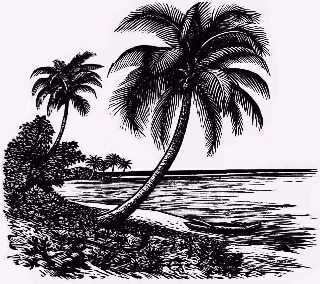
|
Photo essays showing the atoll world of
the Marshalls.
 |
Atolls and their Formation
 Nadikdik
(Knox) Atoll--A Photo Essay Nadikdik
(Knox) Atoll--A Photo Essay
- by Dirk HR Spennemann
- Includes photos of
the beach formation as well as a panoramic view of the lagoon at low
tide
 Mejatto
Island, Kwajalein Atoll--A Photo Essay Mejatto
Island, Kwajalein Atoll--A Photo Essay
- by Dirk HR Spennemann
- Includes aerial photos
of the island
 The
Environment of Mejatto Island, Kwajalein Atoll--A Photo Essay The
Environment of Mejatto Island, Kwajalein Atoll--A Photo Essay
- by Dirk HR Spennemann
- Includes photos of
beachrock formations, old shore lines, as well as vegetation
patterns.
 The
Environment of Mile Atoll--A Photo Essay The
Environment of Mile Atoll--A Photo Essay
- by Dirk HR Spennemann
- Includes photos of
beachrock formations, various plants as well as vegetation patterns.
 Aerial
Views of Kwajalein Atoll--A Photo Essay Aerial
Views of Kwajalein Atoll--A Photo Essay
- by Dirk HR Spennemann
- Includes photos of
Kwajalein, Ebadon, and Mejatto.
 Aerial
Photos of Majuro ("Laura") Island, Majuro Atoll--A Photo Essay Aerial
Photos of Majuro ("Laura") Island, Majuro Atoll--A Photo Essay
- by Dirk HR Spennemann
|

|
The low-lying nature of the islands limits
the extent of the terrestrial fauna. Bird-life, however, is abundant.
Find out about the mammals, reptiles, birds and fish of the Marshall Islands.

|
 Marshallese
Naming of Birds Marshallese
Naming of Birds
- compiled and edited by Dirk H.R. Spennemann
- As with many traditional
cultures, the Marshallese view of the avifauna can be split into two
categories: those birds either edible or useful, and those birds with
are neither.
 The
occurrence of owls in the Marshall Islands The
occurrence of owls in the Marshall Islands
- by Dirk HR Spennemann
- Short-eared Owls (Asio
flammeus) are capable of crossing long stretches of open water and
have been successful colonisers of islands. In the Central Pacific two
established populations (on Hawaiˇi and on Pohnpei in Micronesia) seem
to be the foci of repeated dispersal events. The paper reviews the historic
and linguistic record for the occurrence of owls on the scattered atolls
of the Marshall Islands, the easternmost group of Micronesia
 Notes
on the Avifauna of Ebon Atoll, Marshall Islands Notes
on the Avifauna of Ebon Atoll, Marshall Islands
- by Dirk HR Spennemann and Hemley Benjamin
- The avifauna of Ebon
Atoll, the southernmost atoll of the Republic of the Marshall Islands
is reviewed, using modern sightings as well as historical and modern
records. The species variety is found more abundant than so far reported.
 Holocanthus
diacanthus Holocanthus
diacanthus
- former Museum Godeffroy (Hamburg)-- Type Specimens
of Fishes
 Lethurus
bonhamensis Lethurus
bonhamensis
- former Museum Godeffroy (Hamburg)-- Type Specimens
of Fishes, collected by Johann Kubary (?) at Jaluit
 Naseus
vlamingii Naseus
vlamingii
- former Museum Godeffroy (Hamburg)-- Type Specimens
of Fishes, collected by Johann Kubary (?) at Jaluit
 Apogon
graeffii Apogon
graeffii
- former Museum Godeffroy (Hamburg) -- Type Specimens
of Fishes, collected by Johann Kubary (?) at Majuro
 Serramus
medurensis Serramus
medurensis
- former Museum Godeffroy (Hamburg)-- Type Specimens
of Fishes, collected by Johann Kubary (?) at Majuro
 Zanchus
cornutus Zanchus
cornutus
- former Museum Godeffroy (Hamburg)-- Type Specimens
of Fishes, collected by Johann Kubary (?)
|
 |
The atolls of the Marshall Islands are very
low lying and have little soil and limited reliable rainfall suitable
for supporting vegetation. As a result the range of vegetation is limited.
Find out about the plants and the uses the Marshallese had for them.
 |
 Plants
and their uses in the Marshalls -- Medicinal Plants Plants
and their uses in the Marshalls -- Medicinal Plants
- compiled by Dirk H.R. Spennemann
- Table of plants, their
Marshallese names and their traditional uses as medicinal plants
 Plants
and their uses in the Marshalls -- Food Plants Plants
and their uses in the Marshalls -- Food Plants
- compiled by Dirk H.R. Spennemann
- Table of plants, their
Marshallese names and their traditional uses as food plants
 Plants
and their uses in the Marshalls -- Plants used for construction and
tools Plants
and their uses in the Marshalls -- Plants used for construction and
tools
- compiled by Dirk H.R. Spennemann
- Table of plants, their
Marshallese names and their traditional uses for house and boat construction
as well as the manufacture of tools
 Colonising
Coconuts--A Photo Essay Colonising
Coconuts--A Photo Essay
- by Dirk HR Spennemann
 Plants
in the Marshall Islands--A Photo Essay Plants
in the Marshall Islands--A Photo Essay
- by Dirk HR Spennemann
 Traditional
utilization of Mangroves in the Marshall Islands Traditional
utilization of Mangroves in the Marshall Islands
- by Dirk HR Spennemann
- Mangroves are shoreline
plants thriving in brackish seawater. Traditionally, the wood and the
propagules were used for various purposes. Mangroves, mainly Brugiera
sp. were planted by the Marshallese for coastal protection and the consolidation
of newly created land.
|
 |
The Marshall Islands are made up of atolls
and raised coralline islands. Find out about the origin of atolls and
the nature of island formation.
 |
Atolls and their Formation
 Nadikdik
(Knox) Atoll--A Photo Essay Nadikdik
(Knox) Atoll--A Photo Essay
- by Dirk HR Spennemann
- Includes photos of
the beach formation as well as a panoramic view of the lagoon at low
tide
 Mejatto
Island, Kwajalein Atoll--A Photo Essay Mejatto
Island, Kwajalein Atoll--A Photo Essay
- by Dirk HR Spennemann
- Includes aerial photos
of the island
 The
Environment of Mejatto Island, Kwajalein Atoll--A Photo Essay The
Environment of Mejatto Island, Kwajalein Atoll--A Photo Essay
- by Dirk HR Spennemann
- Includes photos of
beachrock formations, old shore lines, as well as vegetation patterns.
 The
Environment of Mile Atoll--A Photo Essay The
Environment of Mile Atoll--A Photo Essay
- by Dirk HR Spennemann
- Includes photos of beachrock
formations, various plants as well as vegetation patterns.
 Aerial
Views of Kwajalein Atoll--A Photo Essay Aerial
Views of Kwajalein Atoll--A Photo Essay
- by Dirk HR Spennemann
- Includes photos of
Kwajalein, Ebadon, and Mejatto.
 Aerial
Photos of Majuro ("Laura") Island, Majuro Atoll--A Photo Essay Aerial
Photos of Majuro ("Laura") Island, Majuro Atoll--A Photo Essay
- by Dirk HR Spennemann
 The
waves of 1979. Erosion on Majuro Atoll--A Photo Essay The
waves of 1979. Erosion on Majuro Atoll--A Photo Essay
- by Dirk HR Spennemann
 The
waves of 1989. Erosion on Majuro ("Laura") Island, Majuro Atoll--A Photo
Essay The
waves of 1989. Erosion on Majuro ("Laura") Island, Majuro Atoll--A Photo
Essay
- by Dirk HR Spennemann
 Gifts
from the waves. Gifts
from the waves.
- A case of marine transport of obsidian to Nadikdik
Atoll and the occurrence of other drift material in the Marshall Islands.
- Johnstone Centre of Parks,
Recreation and Heritage Report Vol. 23. Johnstone
Centre of Parks, Recreation and Heritage, Charles Sturt University:
Albury, NSW
- by Dirk HR Spennemann
|
 |
The climate of the Marshall Islands is oceanic.
Typhoons are rare. But because of the low-lying nature of the islands,
when typhoons do strike,they are devastating...
 |
 Non-traditional
settlement patterns and typhoon hazard on contemporary Majuro Atoll,
Republic of the Marshall Islands Non-traditional
settlement patterns and typhoon hazard on contemporary Majuro Atoll,
Republic of the Marshall Islands
- by Dirk HR Spennemann
-
 Recalling
the Typhoon of 30 June 1905 and its aftermath Recalling
the Typhoon of 30 June 1905 and its aftermath
- by Dirk HR Spennemann
-
 Stormy
Years. On the Association between the El Niño/Southern Oscillation
phenomenon Stormy
Years. On the Association between the El Niño/Southern Oscillation
phenomenon
- and the occurrence
of typhoons in the Marshall Islands
- by Dirk HR Spennemann and G Marschner
- An analysis of the
historic record of typhoons in the Marshall Islands has identified a
significant association between the occurrence of the El Ničo/Southern
oscillation phenomenon (ENSO) and the occurrence of typhoons in the
Marshall Islands. Whilst typhoons normally occur further to the east,
the warming of the ocean waters around the Marshall Islands, as part
of the ENSO phenomenon, generates typhoons further to the west.
The results suggest that typhoons are 2.6 times more likely to occur
during ENSO years, with a 71% chance of a typhoon striking during an
ENSO year, and only a 26% chance of one happening during a non-ENSO
year. This has implications for planning and public safety, which the
relevant authorities may wish to take note of.
- [PDF
document, Full text, download here (675 kb)]
 Hindcasting
the Effects of Typhoons in Micronesia using German Colonial Records
(Web-based Presentation) Hindcasting
the Effects of Typhoons in Micronesia using German Colonial Records
(Web-based Presentation)
- by Dirk HR Spennemann
- WARNING:
The slide show is quite heavy on images, some of which may be slow to
load.
|






